Delphi Archaeological Museum
The Museum of Delphi is considered among the three most important museums in Greece, together with the ones of the Acropolis of Athens and in Heraklion, Crete. What makes a visit to the Greek Museums in general, this one in particular, an unforgettable experience, is the fact that they usually exist on the very archaeological site(s), thus putting the exhibits in the surroundings in which they were initially established, in close relevance to their cultural and/or religious role.
The Delphi Museum first opened its doors tο the public in 1903; in the more than 100 years that have elapsed since then, it has been recognized as one of the most important museums in Greece. It has undergone many renovations during this time and four different exhibitions, each reflecting the scientific concepts and artistic standards as they evolved through the 20th century. The quality of the exhibits, though, has always been the main advantage of this Museum.
According to Rosina Colonia, (Delphi Ephorate of Antiquities) “… the Delphi exhibits speak for themselves: they have the power to command respect and captivate the visitor, inviting him or her to admire them, and leaving this visitor with the memory of their charm and the enigma surrounding them. Even though the exhibits on display today constitute no more than a small but representative part of the dedications seen by Pausanias at Delphi, and an even smaller part of the many more that inundated the sanctuary during the years of its heyday, they indisputably continue to delight people with their wealth, variety and beauty. …Delphi has been included in archaeology textbooks, it has adorned art books; some of the Delphi finds, such as the Treasury of the Siphnians, are landmarks in the history of ancient Hellenic art, while others, even though more than one hundred years have elapsed since they came to light, continue to be a focal point of scholarly discussions even today, owing to unanswered questions regarding their identity and interpretation. But above all, they still chaim the broad public who flock, like ancient pilgrims, to admire the monuments of Delphi”. (Quotation ©: John S. Latsis Public Benefit Foundation)
Photos will be gradually added in the near future
Select Page of the Album:
Click on any of the pictures to enlarge.
Terracotta TilesTThe excavations in Delphi brought to light many terracotta tiles, antefixes and rain gutters that originated from the roofs of buildings in the sanctuaries of Apollo and Athena Pronaia. Many of them have been identified as belonging to specific monuments, especially treasuries and porticoes that we know from the sources or from excavations, while others adorned unidentified buildings. All of the tiles were richly colored and decorated with a variety of forms.
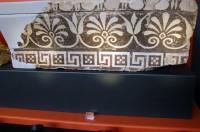
Roof terracottas from the 'Lesche of the Knidians', the building famous for its painted compositions (Fall of Troy, Descent to Hades) on the interior walls by Polygnotos of Thasos
7. Sima fragment, decorated with astragal, palmettes alternating with lotus flowers, meander and checkerboard pattern. Circa 450 BC. |
|
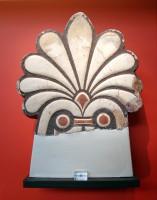
Roof terracottas from the 'Lesche of the Knidians', the building famous for its painted compositions (Fall of Troy, Descent to Hades) on the interior walls by Polygnotos of Thasos.
8. Palmette-shaped antefix. Circa 450 BC. |
|
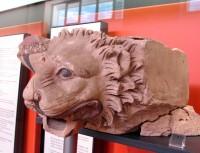
Parts of terracotta roofs with painted decoration which stand out for their rich colors and variety of decorative motifs.
1-2. Parts of corner simas (eaves troughs) with lion-head water-spouts decorated with schematic leaves, meander and checkerboard pattern. They are probably from a stoa at the beginning of the sacred way. Late 5lh century BC. |
|
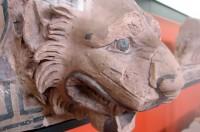
Parts of terracotta roofs with painted decoration which stand out for their rich colors and variety of decorative motifs
1-2. Parts of corner simas (eaves troughs) with lion-head water-spouts decorated with schematic leaves, meander and checkerboard pattern. They are probably from a stoa at the beginning of the sacred way. Late 5th century BC. (Same head as in the previous photo) |
|
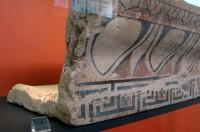
Parts of terracotta roofs with painted decoration which stand out for their rich colors and variety of decorative motifs
1-2. Parts of corner simas (eaves troughs) with lion-head water-spouts decorated with schematic leaves, meander and checkerboard pattern. They are probably from a stoa at the beginning of the sacred way. Late 5th century BC. |
|
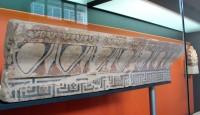
Parts of terracotta roofs with painted decoration which stand out for their rich colors and variety of decorative motifs
1-2. Parts of corner simas (eaves troughs) with lion-head water-spouts decorated with schematic leaves, meander and checkerboard pattern. They are probably from a stoa at the beginning of the sacred way. Late 5th century BC. (Same sima as in the previous photo) |
|
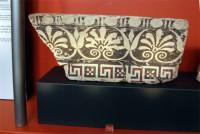
Parts of terracotta roofs with painted decoration which stand out for their rich colors and variety of decorative motifs
3-6. Fragments of simas from unidentified 5th century BC. buildings of the sanctuary, decorated with astragals, palmettes alternating with lotus flowers, meanders and checkerboard pattern. |
|
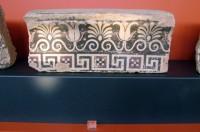
Parts of terracotta roofs with painted decoration which stand out for their rich colors and variety of decorative motifs
3-6. Fragments of simas from unidentified 5th century BC. buildings of the sanctuary, decorated with astragals, palmettes alternating with lotus flowers, meanders and checkerboard pattern. |
|
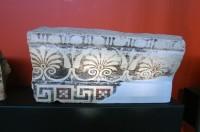
Parts of terracotta roofs with painted decoration which stand out for their rich colors and variety of decorative motifs
3-6. Fragments of simas from unidentified 5th century BC. buildings of the sanctuary, decorated with astragals, palmettes alternating with lotus flowers, meanders and checkerboard pattern. |
|
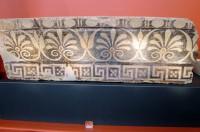
Parts of terracotta roofs with painted decoration which stand out for their rich colors and variety of decorative motifs
3-6. Fragments of simas from unidentified 5th century BC. buildings of the sanctuary, decorated with astragals, palmettes alternating with lotus flowers, meanders and checkerboard pattern. |
|
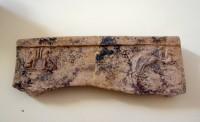
Terracotta rain gutter
18. Part of terracotta roof revetment with galloping horse-rider and facing lions in relief. From an unidentified small votive building of the sanctuary. Second half of the 8th c. BC. |
|
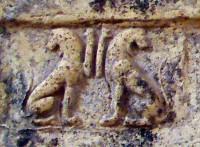
Terracotta rain gutter
18. Facing lions in relief from the previous photo. From an unidentified small votive building of the sanctuary. Second half of the 8th c. BC. |
|
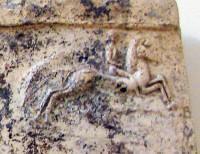
Terracotta rain gutter
18. Part of the previously shown terracotta roof revetment with galloping horse-rider in relief. From an unidentified small votive building of the sanctuary. Second half of the θ* c. BC. |
|
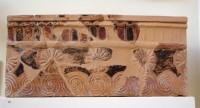
Terracotta rain gutter
19. Part of terracotta sima revetment with bichrome tongue-shaped leaves, rosettes and running spiral in relief. It is attributed to the archaic treasury of the Corkyreans, of which the location is still unknown. 580 BC. |
|
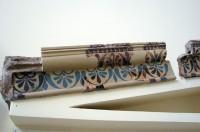
Terracotta Simae
9. Left end of a raking sima decorated with lotus and palmette. It preserves the corner waterspout formed as a lion-head with a square recess on top to receive the acroterion. From an unidentified building of the sanctuary. 540-530 BC. |
|
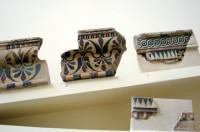
Terracotta Simae
10. Sima fragment, which belongs together with the previous one (n° 9). 540-530 BC.
11. Sima fragment. The rich decoration included tress, rosettes within 'metopes', tooth pattern and finally guttae above meander. Stylistically the fragments preserving guttae (nrs. 14-15) belong together with this type of sima. Circa 560 BC. |
|
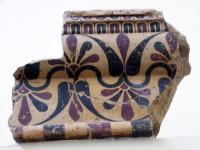
Terracotta Simae
10. Sima fragment, detail
credit: Smaro Mendrinou |
|
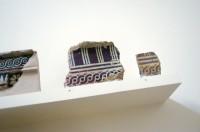
Terracotta Simae
12. Right end of raking sima, with painted tress and tongue-shaped leaves, curved outwards. 560-550 BC.
13. Sima fragment with tongue-shaped leaves. It is attributed to the opposite pediment of the previous building (nr. 12). 560-550 BC. |
|
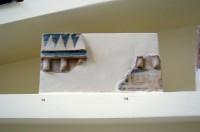
Terracotta Simae
14-15. Sima fragments decorated with guttae, tooth-pattern and meander. Typologically they belong together with sima nr 11 and they might actually come from the same roof. 560-550 BC. |
|
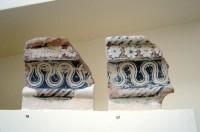
Terracotta Simae
16-17. Sima fragments with colorful painted decoration of oblique lines, wavy bands and rosettes. They are attributed to the same roof, possibly of some treasury of the 6th c. BC. |
|
Select Page of the Album:
|
|



